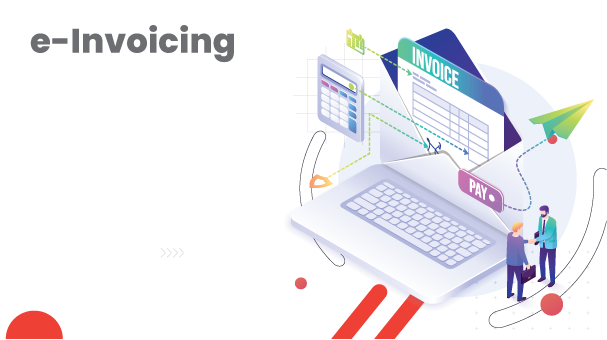Many structural and procedural changes have been brought in GST to ensure ease of compliance by the taxpayers and mitigate difficulties. In the 35th GST Council meeting held on 21st June 2019, e-Invoicing in GST was recommended, which was approved in the 37th GST Council meeting held on 20th September 2019. Through the Notifications 68/2019-Central Tax to 70/2019-Central Tax, a guide for e-Invoicing under GST was made public by the Government. Various e-Invoicing notifications were issued after that to bring more clarity to the concept.
What is e-Invoicing in GST?
e-Invoice, also known as an electronic invoice, is a system where another software can read the invoices raised by one software. It is facilitated by standardization of the invoice format that enables the other software to capture the details of the invoice.
e-Invoicing Applicability
The e-Invoicing System was initially planned to be applicable from 1st April 2020 for all the taxpayers with an annual aggregate turnover of more than Rs. One hundred crores, however, due to the sudden outbreak of the Covid-19 pandemic, its implementation was delayed, and phase-wise implementation was done. As a result, various timelines for the same are as follows:
*Aggregate Turnover has been defined under Section 2(6) of the Central Goods and Services Tax Act, 2017.
The e-Invoicing system is applicable for every taxpayer crossing the above threshold limits. However, the following persons have been exempted from e-Invoicing in GST:
- Units in Special Economic Zones (SEZs).
- Goods Transport Agency engaged in the transportation of goods in a goods carriage by road.
- A registered person engaged in providing services relating to admission to the exhibition, in multiplex screens, of cinematographic films.
- An insurer, banking company, or financial institution also including an NBFC (Non-Banking Financial Company).
- A registered person engaged in providing passenger transportation services.
e-Invoicing under GST Notification No. 13/2020 amended vide Notification No. 70/2020, and 88/2020 shall be applicable after considering the annual aggregate turnover from 2017-18 onwards.
Basic Terminologies
Before going through the e-Invoicing system procedure, let’s go through some basic terminologies:
e-Invoice Schema
A standard invoice format has been structured to facilitate interoperability between the different software. This format is called e-Invoice Schema, and it is prescribed in FORM GST INV-1. The latest schema was notified via Notification No. 60/2020-Central Tax, dated 30th July 2020.
Invoice Registration Portal
It is the portal where GST e-Invoice shall be uploaded or reported. The original GST e-Invoice portal is https://einvoice1.gst.gov.in/, and the trial portal is https://einvoice1-trial.nic.in/.
Invoice Reference Number (IRN)
Also known as IRN, a unique reference number is generated by a computer algorithm for every GST e-Invoice uploaded by the registered person.
Quick Response Code (QR Code)
The IRP, along with IRN, will generate a QR Code for every invoice that will contain IRN and some unique details already encapsulated in the invoice.
Procedure for e-Invoicing under GST
The procedure for e-Invoicing in GST is as follows:
Step-1: Seller should generate an invoice using his accounting or billing software. Those suppliers not having the software may use the free offline tool available on the portal. However, the foremost requirement is that the invoice generated must conform to the standard schema (FORM GST INV-1). In addition, it must create a JSON file of the invoice as the IRP only considers a JSON file.
Step-2: Upload the JSON file to the IRP. It can be done either directly on the IRP or through any GSP or software available.
Step-3: The IRP will verify the invoice details to check whether all the required details have been furnished in the invoice and there is no duplication of invoices. It will generate IRN, and upon confirmation, the signature of IRP will be added to the invoice data and the QR code to the JSON.
Step-4: Digitally signed JSON file of the invoice containing IRN and QR code will be returned to the supplier. Also, the uploaded invoice details will be shared with the GST and the e-Way bill systems, thereby relieving the supplier to furnish the exact details thrice. These details will then be updated in the GSTR-1 as well.
Thus, the e-Invoicing system is one of the features of GST that may even prove fruitful for GST audit and filing various returns within GST return due date.
FAQs
Q: Is the e-Invoicing system applicable for reverse charge transactions as well?
A: Yes! e-Invoicing is applicable for RCM under GST as well.
Q: When should we start generating e-Invoices after crossing the threshold limit?
A: e-Invoice under GST should be generated from the next financial year after crossing the threshold limit. For example: if the turnover limit was crossed in FY 2018-19, the GST e-Invoice should be generated from 01-04-2019.
Q: Are credit notes and debit notes covered under the e-Invoicing system?
A: Debit and credit notes covered under Section 34 of the CGST Act shall be reported in the e-Invoicing system.
Q: Whether GST e-Invoicing can be done voluntarily?
A: Presently, GST e-Invoicing cannot opt voluntarily. Only those who have crossed the threshold limits shall use the e-Invoicing system.
Q: What is the e-Invoicing advantage?
A: The various advantages of GST e-Invoicing include:
- Automatic generation of e-Way bills.
- Automatic reporting of invoices in GST returns, thereby timely filing of the return within the GST Return date.
- Interoperability and standardization of invoices.
- Reduction of disputes due to issues in reporting of transactions.
- Reducing processing costs.
How WeP facilitates e-Invoicing for the suppliers?
WeP has been empaneled as the GST Suvidha Provider (GSP) by the GSTN to facilitate the taxpayers’ compliance procedures. To ensure smooth compliance of e-Invoicing facilities, WeP has ensured a wide range of functions such as bulk uploading invoices, prompt cancellation of e-Invoice, print and download facility, multiple reports availability, and a well trained and professional support team.

